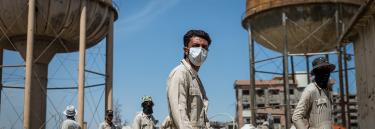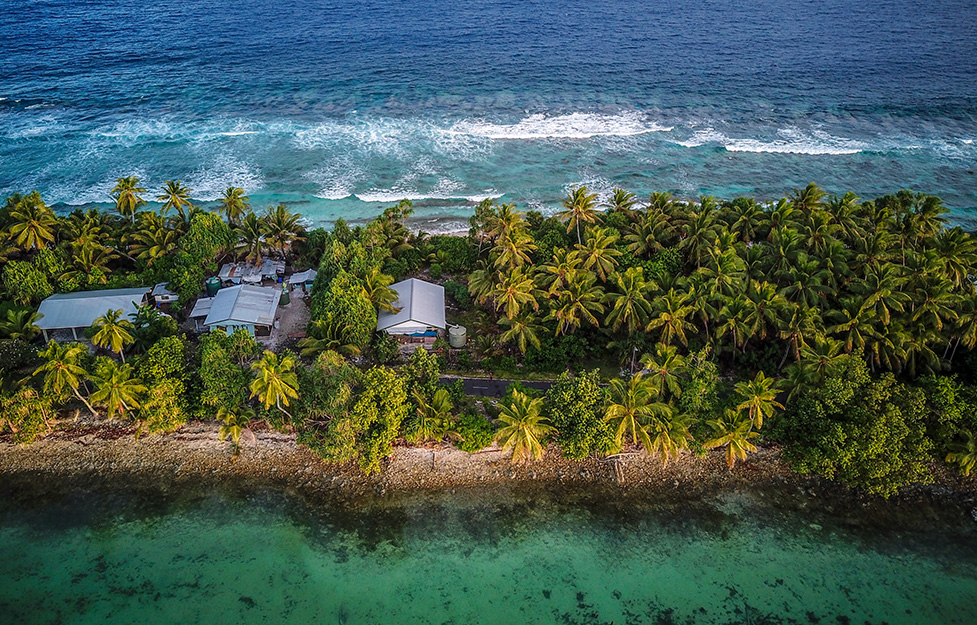
Building on the 2021 State of Ambition Report, these Regional Snapshots dive into regional insights, gaps, trends, and opportunities. They unpack global and regional trends and status with an updated analysis (as of June 15, 2022) on NDC Submissions, ambition, and quality, as well as NDC implementation readiness.

Photo: Jean Damascene Hakuzimana / UNDP Chad
View the Snapshots for each region:
It is clear that the world needs greater climate ambition to meet the 1.5 C° goal of the Paris Agreement. As countries continue to submit updated or new National Determined Contributions (NDCs), it is vital to take regular stock of how countries are increasing their ambition, the influence of inclusivity on these commitments, and the country’s ability to implement and report on progress towards their NDC targets. By taking a regional perspective, these snapshots not only provide a regional analysis of ambition and NDC implementation readiness but also highlight regional trends, opportunities, and challenges. The snapshots draw from UNDP’s wealth of experience in supporting developing countries on NDC design and implementation under its flagship programme, the Climate Promise, which supports over 120 countries and territories.
Exploring climate ambition by region
Inclusivity drives ambition in all regions
Evidence shows that when countries increase the ownership and inclusivity of their NDC update process this has a positive correlation with the NDC’s level of ambition. The proposed transformative changes to national economic and development pathways in NDCs require a whole-of-society approach where governments at all levels, alongside private sector, civil society, academia, and the media all have roles to play. To facilitate ownership of the NDC and a just transition through its actions, marginalized and vulnerable groups such as women, youth, Indigenous Peoples, people with disabilities, and the elderly must be part of the NDC revision. Greater inclusion means that the NDC process becomes more transparent, allowing a diversity of stakeholders to influence NDC priorities and ensure that the outcomes of the NDC benefit those most vulnerable. The charts below show how inclusivity impacts ambition from a regional perspective. While there is generally a positive correlation between inclusivity and ambition, different national circumstances and context, such as political will, will also impact ambition, highlighting the complexity of factors that influence a country’s ambition.
Pick a region to explore more insights
Access to finance remains a challenge to NDC implementation in all regions
As a robust policy framework, NDC’s requires countries to have in place a set of “building blocks” that facilitate its effective implementation. UNDP has identified and defined seven areas of “building blocks” based on UNDP’s experience and lessons learned from supporting countries throughout the NDC cycle. They include: coordination, implementation strategy, mainstreaming of targets, financing strategy, finance mobilization, implementation of actions, and transparency.
Select a *category* from the dropdown below to explore further:
All regions are strengthening coordination mechanisms, recognizing the multi-sector and economy-wide reach of NDC targets. However, the Asia and Pacific region leads with the highest percentage of established coordination systems. Prioritizing and sequencing work over multi-year periods of time through NDC Implementation Plans is underway in all regions with Latin America and the Caribbean leading. While progress is being made in all regions mainstream NDC targets into National development plans and budgets, there has been less progress in mainstreaming into sectoral and sub-national plans.
Finance remains a priority but is still a challenge across all regions, reflecting national and global calls to scale-up financing for climate action. Regions have been more successful in mobilizing public finance than private finance and whilst some regions are exceling at developing NDC Finance Strategies, there still remain large gaps in finance planning in others (Europe and Central Asia region and Arab States region).
Across all regions, the implementation of mitigation actions is more advanced than adaptation actions. All countries in the Latin America and the Caribbean region and Europe and Central Asia region are implementing mitigation actions. To support transparency, most regions have begun putting in place elements for an MRV system, but few have a completed system. The Latin America and the Caribbean region leads with the highest percentage of countries with completed MRV systems while the Arab States region has the highest proportion of countries that have not started developing an MRV system.
Bhutan

Photo: Dechen Wangmo / UNDP Bhutan
Leveraging adaptation planning for NDC implementation
Bhutan’s enhanced NDC makes a clear commitment to develop a National Adaptation Plan (NAP) as a mechanism to detail and guide implementation of NDC adaptation priorities.
The Climate Promise supported political engagement with policy makers, parliamentarians, the private sector, academia and civil society. With UNDP support under GCF Adaptation Planning Readiness support, detailed risk and vulnerability assessments in key sectors including public health and water resources have been developed to support the determination of priority adaptation actions that will target the most vulnerable. The NAP will also advance qualitative and quantitative targets relating to adaptation. The NAP is expected to be finalized in 2022.
To complement adaptation planning, the Climate Promise supported a comprehensive roadmap for NDC implementation in the human settlements, industries and energy sectors. Bhutan provides an excellent example of a country where UNDP Climate Promise and NAP support was mutually supporting the development of a 2nd NDC with a comprehensive mitigation and adaptation focus, and a forthcoming NAP that will operationalize that adaptation component of the NDC.
Central African Republic

Photo : UNDP Central African Republic
Increased sector scope raises ambition
The Central African Republic stepped up mitigation ambition in its updated first NDC submitted in January 2022 – committing to unconditional GHG reduction targets of 9.03% by 2025 and 11.82% by 2030 and conditional targets of 14.64% by 2025 and 24.28% by 2030 compared to business-as-usual. This compares to just 5% in the first NDC. To do so, the updated NDC expanded coverage to include the transport, mining, land use, and housing sectors as well as short-lived climate pollutants, including hydrofluorocarbons.
The NDC formulation process was also carried out in a more inclusive manner, with particular attention given to gender mainstreaming across all activities. Data quality was improved, and adaptation planning made more robust with measures based on targeted goals that are consistent with sectoral objectives and aligned with the country’s National Adaptation Plan (NAP). An MRV system is also proposed.
UNDP’s Climate Promise support helped the government improve the quality of the NDC and identify options for raising ambition. This included support to assess costs of climate activities, develop NDC implementation plan and financing strategy, and establish an MRV system. An NDC communication strategy and related tools were developed to support awareness raising, mobilization and engagement of all stakeholders in NDC implementation, in particular youth, women, and indigenous peoples.
Iraq

© UNDP Iraq / Claire Thomas
Political buy-in raises ambition
In Iraq, UNDP built the capacity of the National Climate Change Center under the Ministry of Environment to support the country’s NDC enhancement. With Climate Promise support, Iraq secured high-level political buy-in to raise ambition to accelerate the transition to low-carbon economy in context of being an oil exporting economy.
Iraq has increased its conditional mitigation target by 2% from 13% in the initial NDC of 2015 to 15% in the updated NDC. In addition, the non-conditional mitigation target was increased from 1% to 2% in the updated NDC. Total increase in the NDC mitigation target is 3% by 2030 compared to BAU. The revised NDC seeks to install 12-Gigawat of renewables at the power utility scale, including through private sector investments, which would provide a solid foundation to liberalize and transform the power sector towards low-carbon solutions.
To further support the low-carbon transition and this pillar of the NDC, Iraq is undertaking new large-scale programming on low carbon cities in concert with UNDP. To achieve the NDC mitigation targets that will facilitate a transition to a low-carbon economy, Iraq’s NDC highlights the needs for US$100 billion of investment.
Armenia

Photo: Gor Kroyan / UNDP Armenia
Leveraging partnerships for NDC implementation
In Armenia, under the Climate Promise, UNDP has supported the implementation of the NDC Partnership Plan. UNDP supported the review process, including the organization of public consultations under the NDC Partnership Plan. The Partnership Plan will be reviewed and adjusted in 2022 to reflect the consultation outcomes validated by the government.
To improve coordination and with support from the Federal Ministry for Economic Cooperation and Development of the Government of Germany (BMZ), a NDC Facilitator was embedded in UNDP to support and facilitate the work of national and international stakeholders toward the implementation of the Partnership Plan.
To promote private sector involvement in the Partnership Plan’s implementation, six stakeholder workshops were organized with private sector actors, the government, donor agencies, and the practitioner community. The workshops targeted private sector participants from consulting companies, business associations, banks and non-banking financial institutions, and private sector companies operating in the domain of climate change mitigation and adaptation (such as energy, agriculture, water resources) for the country.
Belize

Photo: UNDP Belize
Strong political will leads to successful NDC alignment with SDGs
Belize’s commitments in its updated NDC and Low-Emissions Developed Strategy (LEDS) demonstrate the leadership of SIDS in stepping up ambition in line with the SDGs. Following the 2020 general election, Belize implemented an ambitious agenda (“Manifesto for Change”) for sustainable development and climate change. This resulted in the new Ministry of Sustainable Development, Climate Change and Disaster Risk Management and the promotion of Belize as a green and sustainable country. Such changes highlight the years of work the government undertook to identify Belize’s vulnerabilities and articulate the importance of climate change to the country’s sustainable development pathway.
Additionally, the NDC and LEDS development processes were more open and transparent. In particular, the review and alignment of NDC targets with the country’s sustainable development agenda were followed at the political level where a wide participation of stakeholders was encouraged. Capacity building with different stakeholders strengthened their participation in the process. As a result, Belize shifted from action only commitments in its first NDC to a quantifiable reduction target and clear links to SDGs. Importantly, NDC targets are aligned to national development plans, including LEDS.
UNDP, together with key partners of the NDC Partnership, was instrumental in supporting the NDC revision process and was the main partner to support the development of Belize’s LEDS. This included an SDG investor mapping process which aimed to explore investment opportunities from the updated NDC and the new LEDS, as well as the national mitigation strategy and action plan. In November 2021, an SDG Investor Map was presented at the National Investor Forum, which attracted more than 1,500 private sector investment entities.

Photo: Aurélia Rusek / UNDP
UNDP is committed to monitoring the global state of climate ambition; reflecting on progress made and taking stock of challenges and opportunities for developing countries. This contributes to UNDP’s efforts to promote and support climate champions as well as a resource to hold countries to account. These new regional snapshots deliver a new/second layer of insights by allowing us to analyze progress across regions, as well as understand specific regional trends.